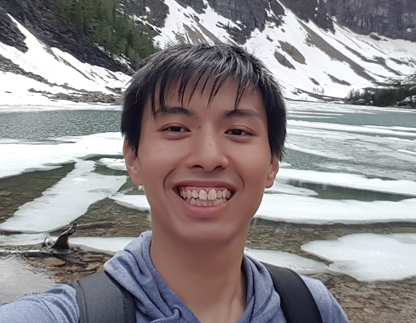I'm presently working on merging laser beams to generate quantum-entangled states. Missed out on becoming Spiderman. Guess I’ll work on Ironman then!”
Max Tan (he/him)
PhD Candidate in Chemistry

Max Tan is a PhD candidate in Chemistry in the Weinberg College of Arts and Sciences. He is a member of the Odom Group, whose research focuses on “controlling materials at the 100-nanometer scale and investigating their size and shape-dependent properties.” Max’s interests lie in nanoplasmonics and optical gain materials.
How would you describe your research and/or work to a non-academic audience?
My work revolves around integrating florescent materials called quantum dots (the "Q" in QLED TVs) with lattices of regularly arranged metal nanoparticle to fabricate small lasers. Because light is strongly enhanced by these lattices, the quantum dots layered on them can get highly excited, enabling the material used in your humble LEDs to lase. As the overall length of these lasers can be even smaller than a millimeter, they are well suited for emerging portable technologies such as VR headsets or autonomous vehicles, and in pixel display technologies.
What have been some of the most memorable twists and turns of your career?
Having the start of my PhD research coincide with the COVID-19 lockdown back in 2020 was an eye-opening and yet enriching experience. It gave me time to not only master the fundamentals to a field that was then new to me, but also to appreciate the merits of slowing down. This time also allowed me to develop the theory in a recently published paper of mine. Despite border restrictions, COVID-19 also closed the distance between me and my home of Singapore. Zoom enabled me to volunteer as a teaching assistant for my alma mater from across the world, allowing me to hone my science communication skills and enjoy the company of familiar faces in a time of isolation.
Tell us what inspired your research and/or work?
I guess you could say it’s a childish fascination with the dangerous: toxic chemicals, burning objects, bright lights, etc. My work is an amalgam of these aspects, where extremely high temperatures are required for synthesizing lead or cadmium-rich quantum dots, which will be later used in high-powered laser setups. My colorblindness further complicates things, which makes research into this field of color purity even more fun.
What is a mistake you have learned from in your career?
Tunnel-visioning into a field or career. Always be open to trying bad experiences. If not, how would you know it’s a bad experience?
Whom do you admire in your field and otherwise, and why?
I've always considered my freshman physics lecturer, Dr Chammika Udalagama, as the Feynman of my generation. His ability to explain things so simply, and with real-life interdisciplinary experiments, set me down this path of physical chemistry. His youthful approach to both teaching and learning made lessons under him much more enjoyable than many other expert professors.
What is the biggest potential impact or implication of your work?
The small, compact sizes of the laser devices make them highly attractive to emerging sensing technologies such as VR headsets and autonomous vehicles. By modifying the arrangement of the metal nanoparticles, the properties of the laser beam (such as polarization, beam shapes and phase) can be altered, with applications in quantum-encrypted and high-bandwidth information transfer.
Why Northwestern?
The ability to conduct highly interdisciplinary and collaborative research with cutting-edge equipment, all located right by the stunning Lake Michigan and the windy city!
How do you unwind after a long day?
Mind-numbing computer gaming sessions with a good beer always helps.
What books are on your bedside table?
I’m a sucker for science history books:
Guns, Germs and Steel by Jared Diamond
Between Genius and Genocide by Daniel Charles
Quantum: Einstein, Bohr, and the Great Debate About the Nature of Reality by Manjit Kumar.
What did you originally want to be when you grew up?
Spiderman!
Tell us about a current achievement or something you're working on that excites you.
I’m super glad about recently publishing my first research paper from grad school and I’m presently working on merging laser beams to generate quantum-entangled states! Missed out on becoming Spiderman. Guess I’ll work on Ironman then!
Tell us about a time when things did not go as you planned, what did you learn?
My latest publication stemmed from a fortuitous accident; I had integrated my quantum dots with the wrong metal nanoparticle array sample, which typically should not show lasing. In my case however, multiple lasing beams emerged, which led me to challenge the assumptions in previously published work.
What are you most proud of in your career to date?
The ability to traverse across different fields (e.g., chemistry, biology, physics) and be able to quickly learn the ropes.
What advice would you give your younger self or someone considering a similar path?
Try something now that you can't try in the future.
Published: July 19, 2022
If you know a graduate student, postdoctoral trainee, graduate faculty member, staff member, or a member of our TGS alumni population who would make a great candidate for our TGS Spotlight Series, please complete this brief TGS Spotlight Series Nomination Form.